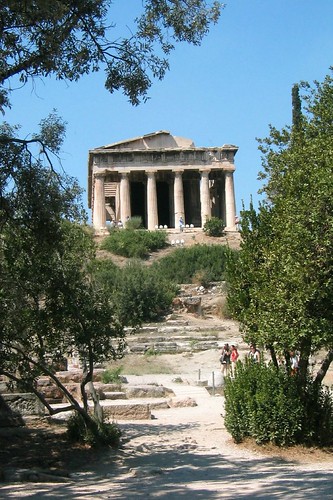 Ancient Agora of Athens
Ancient Agora of AthensIt started as a residential area, but in the 6th century BC, Peisistratus converted it into a centre of Athenian government with a newly built drainage system, fountains and a temple to the Olympian gods. In the 5th century BC there were temples constructed to Hephaestus, Zeus and Apollo. Public meetings, such as those to discuss ostracism, were held in the Agora. During the period of radical democracy (after 509 BC), the Agora was the meeting point of the city council, the presidents of the council, and the magistrates. The Agora was the place where every Athenian citizen gathered to conduct their business, participate in their city's governance, decide judicial matters, express their opinion for all who cared to listen, and elect their city officials. For every free Athenian citizen, participating in such "common" activities was not merely a duty, but instead it was a privilege and an honor. The law courts were located there, and any citizen who happened to be in the Agora when a case was being heard, could be forced to serve as a juror. The Agora in Athens again became a residential area during Rom
 an and Byzantine times. Today there are only three intact monuments in this site:
an and Byzantine times. Today there are only three intact monuments in this site:- Eleventh Century Church which though very recent given the age of the Agora, still worth a visit for the Byzantine frescoes, art and architecture.
- Temple of Hephaistos - It’s one of the few temples which has survived the centuries intact. Even the frieze has survived in its original position in a remarkably complete condition. (Pic 2)
- The Stoa of Attalos - rebuilt by archeologist in the 1950s to serve as the Agora’s museum.
Hence to achieve a sense of accomplishment and gain a fair understanding of the site it is vital to
- Have a map of the ruins. It will help you to understand what lies in front of you. You can click on the link http://en.wikipedia.org/wiki/File:AgoraAthens5thcentury.png for the same.
- Better still get a copy of Lonely Planet to make sense of the rock debris and aquaint yourself with what stood at the site years ago so as to enable the flow of imagination
- Have the ability to appreciate history
Do understand that when you walk through the rubble you will be passing monuments like
- Heliaea - It was the supreme court of ancient Anthens and the scene of famous trials Trial of Socrates and the Trial of Pericles
- Metroon (Old Bouleuterion) – the meeting chamber of the city council till the new Bouleuterion was built post which it was dedicated to the mother goddess.
- New Bouleuterion – It housed the council of citizens in Ancient Greece
For more information click on the following links: http://en.wikipedia.org/wiki/Ancient_Agora_of_Athens; http://www.stoa.org/athens/sites/agoraguide4/
 The Arch of Hadrian
The Arch of HadrianIt is a monumental gateway built to celebrate the visit of Roman Emperor Hadrian. The arch was built over the line of an ancient road.
For more information click on the following link(s)
http://en.wikipedia.org/wiki/Arch_of_Hadriana.org/wiki/Arch_of_Hadrian; http://www.stoa.org/athens/sites/archofhadrian/source/d000130005.html
Temple of Olympian Zeus

Dedicated to Zeus, king of the Olympian gods the construction of the temple began in the 6th Century by Peisistratos and was not finished till the next 700 years. The Roman emperor Hadrian completed it in 131 AD. During the Roman periods it was the largest temple in Greece and housed one of the largest cult statues. Today the massive ruins do give us an idea of the magnitude of this project.
For more information click on the following link(s)
http://en.wikipedia.org/wiki/Temple_of_Olympian_Zeus_(Athens)




No comments:
Post a Comment